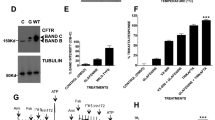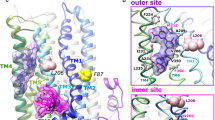Abstract
HSC70 has been identified as an important molecular target involved in the ΔF508-CFTR cystic fibrosis. HSC70 associates ΔF508-CFTR to a much greater extent than WT-CFTR and after this step, it recruits other co-chaperones (BAG1, CHIP) and performs the ubiquitination and proteosomal degradation of the protein. Up to now, several X-ray data concerning the HSC70:BAG1 complexes are available. Thus, we performed an “in silico” investigation focused to explore which different amino acid residues are involved in the binding of ATP, the natural substrate, and the co-crystallized ligands at the HSC70/BAG-1 interface. The study allowed us to evaluate sildenafil and KM11060, which proved to be also CFTR correctors, as potential HSC70:BAG1 inhibitors, and also let us derive interesting perspectives for the development of new CFTR correctors.











Similar content being viewed by others
References
Alberti S, Böhse K, Arndt V, Schmitz A, Höhfeld J (2004) The cochaperone HspBP1 inhibits the CHIP ubiquitin ligase and stimulates the maturation of the cystic fibrosis transmembrane conductance regulator. Mol Biol Cell 15:4003–4010
Amaral MD, Kunzelmann K (2007) Molecular targeting of CFTR as a therapeutic approach to cystic fibrosis. Trends Pharmacol Sci 7:334–341
Griesenbach U, Alton EW (2009) Cystic fibrosis gene therapy: successes, failures and hopes for the future. Expert Rev Respir Med 4:363–371
Kalid O, Mense M, Fischman S, Shitrit A, Bihler H, Ben-Zeev E, Schutz N, Pedemonte N, Thomas PJ, Bridges RJ, Wetmore DR, Marantz Y, Senderowitz H (2010) Small molecule correctors of F508del-CFTR discovered by structure-based virtual screening. J Comput Aided Mol Des 12:971–991
Macias AT, Williamson DS, Allen N, Borgognoni J, Clay A, Daniels Z, Dokurno P, Drysdale MJ, Francis GL, Graham CJ, Howes R, Matassova N, Murray JB, Parsons R, Shaw T, Surgenor AE, Terry L, Wang Y, Wood M, Massey AJ (2011) Adenosine-derived inhibitors of 78 kDa glucose regulated protein (Grp78) ATPase: insights into isoform selectivity. J Med Chem 54:4034–4041
Quinton PM (1983) Chloride impermeability in cystic fibrosis. Nature 301:421–422
Quinton PM, Bijman J (1983) Higher bioelectric potentials due to decreased chloride absorption in the sweat glands of patients with cystic fibrosis. N Engl J Med 20:1185–1189
Riordan JR (2008) CFTR function and prospects for therapy. Annu Rev Biochem 77:701–726
Riordan JR, Rommens JM, Kerem B, Alon N, Rozmahel R, Grzelczak Z, Zielenski J, Lok S, Plavsic N, Chou JL (1989) Identification of the cystic fibrosis gene: cloning and characterization of complementary DNA. Science 4922:1066–1073
Sharp A, Crabb SJ, Johnson PW, Hague A, Cutress R, Townsend PA, Ganesan A, Packham G (2009) Thioflavin S (NSC71948) interferes with Bcl-2-associated athanogene (BAG-1)-mediated protein–protein interactions. J Pharmacol Exp Ther 2:680–689
Williamson DS, Borgognoni J, Clay A, Daniels Z, Dokurno P, Drysdale MJ, Foloppe N, Francis GL, Graham CJ, Howes R, Macias AT, Murray JB, Parsons R, Shaw T, Surgenor AE, Terry L, Wang Y, Wood M, Massey AJ (2009) Novel adenosine-derived inhibitors of 70 kDa heat shock protein, discovered through structure-based design. J Med Chem 52:1510–1513
Acknowledgments
This research was supported by Italian Cystic Fibrosis Foundation (Grant FFC#5/2010), with the contribution of Philip Watch–Morellato & Sector Group. The funders had no role in study design, data collection and analysis, decision to publish, or preparation of the manuscript. E.C. was financially supported by a post-doc fellowship, Area Chimica, University of Genova.
Author information
Authors and Affiliations
Corresponding author
Rights and permissions
About this article
Cite this article
Cichero, E., Basile, A., Turco, M.C. et al. Scouting new molecular targets for CFTR therapy: the HSC70/BAG-1 complex. A computational study. Med Chem Res 21, 4430–4436 (2012). https://doi.org/10.1007/s00044-012-9985-1
Received:
Accepted:
Published:
Issue Date:
DOI: https://doi.org/10.1007/s00044-012-9985-1




